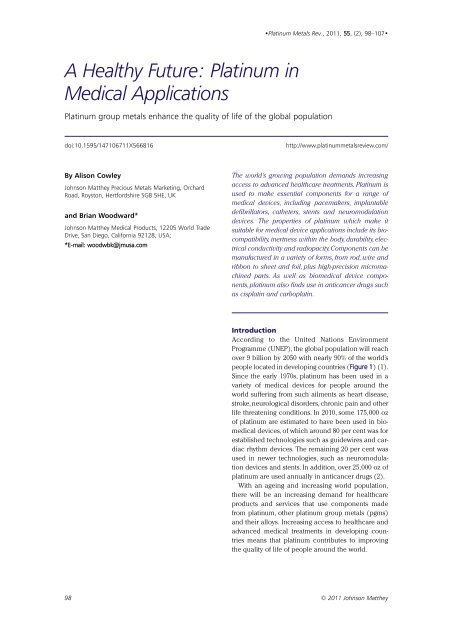Download - Platinum Metals Review
Download - Platinum Metals Review
Download - Platinum Metals Review
Create successful ePaper yourself
Turn your PDF publications into a flip-book with our unique Google optimized e-Paper software.
•<strong>Platinum</strong> <strong>Metals</strong> Rev., 2011, 55, (2), 98–107•<br />
A Healthy Future: <strong>Platinum</strong> in<br />
Medical Applications<br />
<strong>Platinum</strong> group metals enhance the quality of life of the global population<br />
doi:10.1595/147106711X566816<br />
http://www.platinummetalsreview.com/<br />
By Alison Cowley<br />
Johnson Matthey Precious <strong>Metals</strong> Marketing, Orchard<br />
Road, Royston, Hertfordshire SG8 5HE, UK<br />
and Brian Woodward*<br />
Johnson Matthey Medical Products, 12205 World Trade<br />
Drive, San Diego, California 92128, USA;<br />
*E-mail: woodwbk@jmusa.com<br />
The world’s growing population demands increasing<br />
access to advanced healthcare treatments. <strong>Platinum</strong> is<br />
used to make essential components for a range of<br />
medical devices, including pacemakers, implantable<br />
defibrillators, catheters, stents and neuromodulation<br />
devices. The properties of platinum which make it<br />
suitable for medical device applications include its biocompatibility,<br />
inertness within the body, durability, electrical<br />
conductivity and radiopacity.Components can be<br />
manufactured in a variety of forms, from rod, wire and<br />
ribbon to sheet and foil, plus high-precision micromachined<br />
parts. As well as biomedical device components,platinum<br />
also finds use in anticancer drugs such<br />
as cisplatin and carboplatin.<br />
Introduction<br />
According to the United Nations Environment<br />
Programme (UNEP), the global population will reach<br />
over 9 billion by 2050 with nearly 90% of the world’s<br />
people located in developing countries (Figure 1) (1).<br />
Since the early 1970s, platinum has been used in a<br />
variety of medical devices for people around the<br />
world suffering from such ailments as heart disease,<br />
stroke, neurological disorders, chronic pain and other<br />
life threatening conditions. In 2010, some 175,000 oz<br />
of platinum are estimated to have been used in biomedical<br />
devices, of which around 80 per cent was for<br />
established technologies such as guidewires and cardiac<br />
rhythm devices. The remaining 20 per cent was<br />
used in newer technologies, such as neuromodulation<br />
devices and stents. In addition, over 25,000 oz of<br />
platinum are used annually in anticancer drugs (2).<br />
With an ageing and increasing world population,<br />
there will be an increasing demand for healthcare<br />
products and services that use components made<br />
from platinum, other platinum group metals (pgms)<br />
and their alloys. Increasing access to healthcare and<br />
advanced medical treatments in developing countries<br />
means that platinum contributes to improving<br />
the quality of life of people around the world.<br />
98 © 2011 Johnson Matthey
















